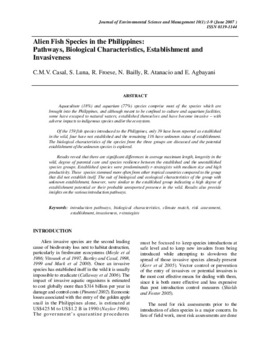Alien fish species in the Philippines: pathways, biological characteristics, establishment and invasiveness
Abstract
Aquaculture (18%) and aquarium (77%) species comprise most of the species which are brought into the Philippines, and although meant to be confined to culture and aquarium facilities, some have escaped to natural waters, established themselves and have become invasive - with adverse impacts to indigenous species and/or the ecosystems. Of the 159 fish species introduced to the Philippines, only 39 have been reported as established in the wild, four have not established and the remaining 116 have unknown status of establishment. The biological characteristics of the species from the three groups are discussed and the potential establishment of the unknown species is explored. Results revealed that there are significant differences in average maximum length, longevity in the wild, degree of parental care and species resilience between the established and the unestablished species groups. Established species were predominantly r-strategists with medium size and high productivity. These species stemmed more often from other tropical countries compared to the group that did not establish itself. The suit of biological and ecological characteristics of the group with unknown establishment, however, were similar to the established group indicating a high degree of establishment potential or their probable unreported presence in the wild. Results also provide insights on the various introduction pathways

